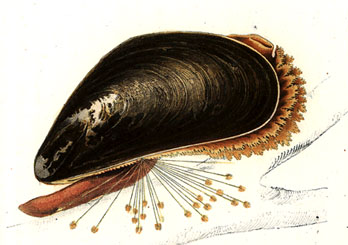 |
If this page has no frames -> main entry page |
 |
| |
Welcome to the
Virtual Handbook on Population Dynamics !
Thematic Introduction Technical Introduction
|
|
| |
 |
Mytilus edulis
Meyer & Möbius, 1872.
Die Prosobranchia und Lamellibranchia der Kieler Bucht. Leipzig. |
|
|
| |
Why is this Handbook a "virtual" one?
For some years now, I worked on a manual of methods used in benthic population dynamics. In the begining I wrote it for myself, later for use in various practicals. Finally I decided to re-do the whole thing in a more systematic way with the intention of future publication as a little booklet.
Sofar this handbook is exclusively "virtual" because of several reasons:
- Publication of a hardcopy version may take years.
- The virtual handbook is accessable from any place in the world.
- The virtual handbook can be updatedwhenever necessary.
- The virtual handbook is intended to be interactive.
I invite all users to send me their comments on the book.
Any suggestions for improvements are welcome and will be acknowledged accordingly.
|
|
| |
What is the Purpose of this Handbook?
This book is a compilation of the state-ot-the-art tools for the analysis of population dynamics in benthic invertebrates. It is an attempt to systemise our present knowledge and to pass it on to the next generation of scientists. The handbook deals with
- the models used to describe certain processes, such as growth, mortality etc.,
- the “mathematical” tools used to apply these models to data, and
- the data required for using these tools.
Most of the models introduced here are quite simple, and surely well known to many readers. The calculation tools and mathematical abilities required are pretty simple, too. Anybody who can handle spread sheets and linear regression will be fine with most tools. The only tricky topic may be the iterative fitting of nonlinear equations, but these days even MS EXCEL is able to do this. Concerning the data required, the handbook intends to cover a wide range of useful methods to produce suitable data for a certain task.
|
|
| |
Different Points of View - Fishery Biologist versus Benthic Ecologist
Usually, a fishery biologist has an economical point of view. He (she) is thinking in terms of catch per unit effort, marketable size, and maximum sustainable yield. This is also the case with respect to commercially important benthic invertebrates.
A benthic ecologist thinks in ecological terms most of the time. He (she) is interested in the position of a certain population in the food web and in the interaction web, and in the adaptations which makes this species more or less successful in a certain environment.
At the level of population dynamics, the fields of the fishery biologist and the benthic ecologist overlap. Both are interested in:
- amount of food available
- quality and quantity of the food
- the efficiency of the conversion of food into tissue
- reproduction
- growth and age
- survival and mortality
- production and production-to-biomass (P/B) ratio
Therefore both partially use the same methods of sampling and analyzing the population under investigation. However, their intentions and the conclusions they draw from their results may be different.
|
|
 |
|
 |
|
|
